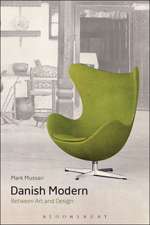A John Heskett Reader: Design, History, Economics
Editat de Clive Dilnot Autor John Hesketten Limba Engleză Paperback – 27 iul 2016
Toate formatele și edițiile
| Toate formatele și edițiile | Preț | Express |
|---|---|---|
| Paperback (1) | 242.34 lei 6-8 săpt. | |
| Bloomsbury Publishing – 27 iul 2016 | 242.34 lei 6-8 săpt. | |
| Hardback (1) | 773.81 lei 6-8 săpt. | |
| Bloomsbury Publishing – 27 iul 2016 | 773.81 lei 6-8 săpt. |
Preț: 242.34 lei
Preț vechi: 276.07 lei
-12% Nou
Puncte Express: 364
Preț estimativ în valută:
46.37€ • 50.53$ • 39.07£
46.37€ • 50.53$ • 39.07£
Carte tipărită la comandă
Livrare economică 23 aprilie-07 mai
Preluare comenzi: 021 569.72.76
Specificații
ISBN-13: 9781474221269
ISBN-10: 1474221262
Pagini: 382
Ilustrații: 30 bw illus
Dimensiuni: 156 x 234 x 20 mm
Greutate: 0.59 kg
Editura: Bloomsbury Publishing
Colecția Bloomsbury Academic
Locul publicării:London, United Kingdom
ISBN-10: 1474221262
Pagini: 382
Ilustrații: 30 bw illus
Dimensiuni: 156 x 234 x 20 mm
Greutate: 0.59 kg
Editura: Bloomsbury Publishing
Colecția Bloomsbury Academic
Locul publicării:London, United Kingdom
Caracteristici
Heskett was British but taught in the US at Illinois Institute of Design and in Hong Kong at Hong Kong Polytechnic University for many years
Notă biografică
Clive Dilnot is professor of Design Studies at Parsons The New School for Design, New York, USA. Recent publications include Ethics? Design? (2005) and, as co-author, Design and the Question of History (Bloomsbury, 2014).
Cuprins
Introduction: Clive DilnotI. Key ThemesIntroduction 1. What is Design? 2. Commerce or Culture? Industrialization and Design3. Design from the Standpoint of Economics/Economics from the Standpoint of DesignII. Design in History & the History of Design Introduction (A) Designing and Making in the Pre-Industrial World4. Some Lessons of Design History5. Crafts, Commerce, Industry6. Chinese Design: What Can We Learn from the Past?7. Three moments in the History of Making: Nomads, Traders, Slaves(B) Designing in the Industrial World8. The 'American System' and Mass Production9. Writing the History of Design in the Industrial World10. The Growth of Industrial Design in Japan(C) Design in Germany 1870-194511. Government Policy & German Design 1870-191812. The Industrial Applications of Tubular Steel 13. Modernism and Archaism in Design in the Third Reich III. Design, Business, EconomicsIntroduction (A) Corporate design strategiesSharon Helmer Poggenpohl: Design between Economics and Practice14. GM: The Price of Corporate Arrogance 15. Everything Changes, Nothing Alters 16. Design Management in Phillips in the 1980s17. Teaching an Old Dog New Tricks: How RCA is using Design as a Strategic Tool 18. Current and Future Demands on Hong Kong Designers(B) National Design PoliciesCarlos Texeiria: John Heskett and design policy 19. National Design Policy and Economic Change20. Learning from Germany's Integrated Design Policy21. Design and Industry in China22. A Design Policy for the UK: Three Suggestions(C) Creating Value by DesignTore Kristensen: John Heskett's contribution to the business and economics of design23. Creative Destruction: The Nature and Consequences of Change through Design24. Product Integrity25. Cultural Human Factors26: Creating Economic Value by DesignIV. ReflectionsIntroduction27. Past, Present and Future in Design 28. Reflections on Design and Hong Kong29. On WritingV. Last Words30. Can the Centre Hold?List of acronyms ContributorsPermissions and Acknowledgments Appendix: A first bibliography of John Heskett's published workIndex
Recenzii
The Heskett reader is a must for designers, historians, economists, and students who are considering the charged relationship between design and the world. In a remarkable collection, Dilnot has brought together essays that make Heskett's global and multidisciplinary reach evident. It is a pleasure to see Heskett's classic texts - along with some of his unpublished work - brought together in one marvellous book.
John Heskett's personal voice, quiet intensity, and certain integrity bring to his writings on design an unshakeable sense of its profound implications. This collection encompasses early work in design history, reflections on design in business, and observations on design in Hong Kong, and also summarizes events of his substantial career.
From design history's early years in the 1970s to governments worldwide reengaging with design in the 2000s, Heskett brought a clear, inimitable voice to design writing, thinking and practice and shaped how generations of designers and historians learnt to see design: embedded in economic and social structures, and having real social and economic impact. The readings collected here underscore the importance of design for policymaking, past and present, and show how economics and policymaking benefit from a historian's eye. His ideas are as fresh and important now as when first written.
Heskett's distinctive contribution to the early shaping of design history introduced social, political and economic history as integral dimensions of study and research in the field. He later contributed insights into design economics, policy and management at a time when such terms were too often bandied about imprecisely.
Clive Dilnot's edition of A John Heskett Reader: Design, History, Economics is a curious anomaly to all of the above Reader categories. This is the first Reader in design history that is singularly arranged around the oeuvre of one of its pioneers.Dilnot's mission is to present a selection of Heskett's writing-not to pick it apart but to provide starting points for further enquiry.
John Heskett's personal voice, quiet intensity, and certain integrity bring to his writings on design an unshakeable sense of its profound implications. This collection encompasses early work in design history, reflections on design in business, and observations on design in Hong Kong, and also summarizes events of his substantial career.
From design history's early years in the 1970s to governments worldwide reengaging with design in the 2000s, Heskett brought a clear, inimitable voice to design writing, thinking and practice and shaped how generations of designers and historians learnt to see design: embedded in economic and social structures, and having real social and economic impact. The readings collected here underscore the importance of design for policymaking, past and present, and show how economics and policymaking benefit from a historian's eye. His ideas are as fresh and important now as when first written.
Heskett's distinctive contribution to the early shaping of design history introduced social, political and economic history as integral dimensions of study and research in the field. He later contributed insights into design economics, policy and management at a time when such terms were too often bandied about imprecisely.
Clive Dilnot's edition of A John Heskett Reader: Design, History, Economics is a curious anomaly to all of the above Reader categories. This is the first Reader in design history that is singularly arranged around the oeuvre of one of its pioneers.Dilnot's mission is to present a selection of Heskett's writing-not to pick it apart but to provide starting points for further enquiry.





